Department History
Growth and Development of the Geosciences Department
University of Houston
1927 (or 1934) - 1999
Preface
In 1977 a brief history of the Geology Department (now Geosciences) Department was published in the Department of Geology Alumni Newsletter (1977-78, p. 32-41). During the 1977-78 academic year President Philip Hoffman declared that the "official founding date of the University of Houston was 1927; thus, 1977 marked our "big Five O". Prior to 1977, the campus used 1934 as its official founding date. Those of you who graduated prior to 1977 should check your class rings; you will find 1934 given as the founding year. Those who graduated after 1977 will find 1927 in its place. However appropriate or inappropriate this action was, it may have typified UH. How old is UH? How old do you want it to be?
Regardless of the founding date, the first geology courses were offered in 1934; thus, we celebrate 65 years of instruction in the geosciences this academic year. It seemed appropriate to dust off the 1977 -publication, spruce it up a bit, add some old, and hopefully entertaining illustrations, and distribute the whole package via the Internet.
A history of the Department is beyond our intent (and abilities). In the following text, emphasis is directed toward providing a chronology focusing on accomplishments of our faculty, staff and students. The seemingly simple task of compiling lists of former full-time and part-time faculty was remarkably difficult and no claim is made that the following lists are correct. We would appreciate any additions and comments.
Introduction
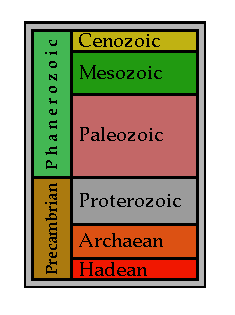 The chronology of the Department of Geology/Geosciences is closely tied to the
history of the University of Houston
The chronology of the Department of Geology/Geosciences is closely tied to the
history of the University of Houston
The Precambrian
In 1926, or so the story goes, a group of concerned high school students met with Dr. E. E. Oberholtzer, Superintendent of the Houston Independent School District. These students expressed concerns about the lack of academic opportunities in the Houston metropolitan area and many of them and their friends could not afford to go to Austin or College Station, as they would have to work at least part-time to pay for their education.
Oberholtzer understood their concern as he had taken nearly 15 years to complete his college work and had supported his family by teaching school during the fall and spring and taking most of his college work during the summer sessions.
In those days the State of Texas allowed school districts to establish junior colleges by simply notifying the State of their intentions. The Houston Independent School District agreed to work with the faculty and administration of the University of Texas at Austin and the Sam Houston State Teachers College to establish a curriculum and to set standards for the hiring of instructions. The Junior College for the City of Houston was established by HISD on March 7, 1927.
The first classes at Houston Junior College were offered at the San Jacinto High School in the summer of 1927 with an enrollment of 230 students. In the fall semester of 1927 a total of 367 students enrolled for courses held from 4:00 PM until past 10:00 PM taught by 21 faculty. Many of these faculty were also employed by HISD and dual employment continued to be the norm for a number of years. In fact, Dr. Oberholtzer continued as superintendent of HISD and head of The Houston Junior College and the Houston Junior College for Negroes until 1945 at which time he resigned as superintendent of HISD and became the first full-time President of UH. Up until that time Oberholtzer "ran" UH from his downtown office and rarely appeared on campus -- expect during registration when fees were collected and budgetary decisions needed to be made "on the spot".
Introductory courses in biology, chemistry, mathematics and physics constituted the science curriculum at the junior college for the first seven years. In many ways the Houston Junior College was nothing more than the 13th and 14th grades. Attempts were made to field a football team but starting practice after 10:00 PM proved difficult even for football crazy Texans. There was a girls basketball team, and in 1927 they won half of their games; a single victory over the Woolworth Female Employees. Classes in the daytime were first offered in meeting rooms of a local church. Conflicts over room use and space allocations with HISD continued throughout the brief history of the Junior College. Early on it appears that Oberholtzer and others (including Kemmerer who became the second president of UH) realized that there was a need for a University of Houston with its own facilities.
In 1928 the Texas Department of Education and the Texas Association of Colleges granted the Houston Junior College full accreditation. In 1933 the Texas Legislature passed a law that allowed school districts with a population of more than 225,000 to raise funds to purchase land and build buildings for its established junior colleges. In addition, the law allowed junior colleges to add additional courses to its curriculum "such that the junior college work and additional college work shall constitute a university". HISD took advantage of this law and in April of 1934 created the University of Houston.
A total of 461 students enrolled for courses taught by 32 faculty members (50% were part-time employees during the summer of 1934. In keeping with the founding concept of educational opportunities for part-time students, an upper limit of 150 students per semester was placed on "day-school" enrollment.
The first courses in Geology were offered in 1934:- General Geology
- Mineralogy and Petrology
- Field Geology and Mapping
- Geology of Texas
Mr. Fred E. Smith and Mr. L. Wood, Humble Oil Company, were the first geology instructors at UH and Smith remained a part-time faculty member until at least 1942. After WWII he taught at TAMU.
Junior and senior level courses were added for 1936-37 and 1937-38 respectively:
- Map Interpretation
- Subsurface Correlation
- Introduction to Paleontology
- Economic Geology
- Geology of North America
The legislative act of 1934 set up provisions for the administration of the newly created universities to receive or purchase land for a campus and build buildings. In 1936 the Board of Trustees of HISD set about the selection of a site for the UH campus. One particularly attractive site was on a 150-acre parcel of land in Memorial Park owned by the City of Houston. After considerable negotiations, the City Council rejected the HISD terms -- namely, that the City of Houston would refrain from developing petroleum prospects at that site. How would we have evolved IF the Memorial Park site had been selected?
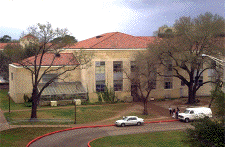 In 1936 the heirs to the J. J. Settegast estate donated 75 acres as a permanent
home for UH. Ben Taub donated an adjoining 35 acres adjacent to St. Bernard Street.
Both families stipulated that construction of the first building must begin on or
before January 1, 1938 or the gift would be withdrawn. At this time the first UH fund
raising effort was inaugurated with Mr. Roy Cullen serving as chairman. The goal was
to raise $1,000,000 to build and equip four permanent buildings. Mr. and Mrs. H. R.
Cullen contributed some $250,000 in memory of their son Roy Gustav Cullen. The HISD
Board of Trustees passed a resolution that the first building, a Liberal Arts and
Culture Center, would be officially known as the Roy Gustav Cullen Memorial Building.
The building was completed in early 1939 and the Science building (the second building
on campus was completed in June of 1939. The Roy Cullen building was first occupied
in the summer session of 1939 and both buildings were in use for the fall semester
of 1939. The Geology Department was housed in the Science building along with Chemistry,
Physics, Biology, Pharmacy, Optometry, and others.
In 1936 the heirs to the J. J. Settegast estate donated 75 acres as a permanent
home for UH. Ben Taub donated an adjoining 35 acres adjacent to St. Bernard Street.
Both families stipulated that construction of the first building must begin on or
before January 1, 1938 or the gift would be withdrawn. At this time the first UH fund
raising effort was inaugurated with Mr. Roy Cullen serving as chairman. The goal was
to raise $1,000,000 to build and equip four permanent buildings. Mr. and Mrs. H. R.
Cullen contributed some $250,000 in memory of their son Roy Gustav Cullen. The HISD
Board of Trustees passed a resolution that the first building, a Liberal Arts and
Culture Center, would be officially known as the Roy Gustav Cullen Memorial Building.
The building was completed in early 1939 and the Science building (the second building
on campus was completed in June of 1939. The Roy Cullen building was first occupied
in the summer session of 1939 and both buildings were in use for the fall semester
of 1939. The Geology Department was housed in the Science building along with Chemistry,
Physics, Biology, Pharmacy, Optometry, and others.
The Precambrian ended in 1940 prior to the hiring of the first full-time geology professor. During the formative years several departmental characteristics were established that continue to the present.
From 1934 until 1940 all courses in Geology were taught during the evening. Even after full-time faculty were hired, emphasis remained on the part- time student. Then, as now, many students majoring in Geology were employed in the Earth Science sector in the Houston area.
From 1937 until 1940 the College of Community Service (Continuing Education) offered a non-credit course in Oil Geology. Today, members of our faculty continue to make themselves available to groups around the world to conduct short courses, field trips and other non-traditional programs.
By 1940 a complete curriculum, leading to the BS degree in Geology had been developed and at least three degrees conferred through the efforts of part- time faculty working with part-time students. Throughout the history of the Department, part-time faculty have made major contributions to our academic programs.
In 1977, John M. Kelley, Consulting Geologist, Midland, Texas, wrote about his experiences in Geology at the University of Houston.The Paleozoic
Dr. Keith M. Hussey (Ph.D., LSU, 1940) joined the faculty of the University of Houston as the first full-time geology professor in 1940. He served from 1940 to 1942 and from 1945 to 1946. During the war all activities of the department were in the hands of part-time faculty (principally Edward J. Barragy). Dr. Hussey retired from Iowa State University in 1979. In 1944 a 22-month program in General Geophysics was established in the School of Technology. Little is recorded about this program and its students and faculty. Several courses were offered in vacuum tube technology, as this was a cutting-edge technology effort.
In 1945 the Board of Trustees of HISD adopted a resolution that stated that the management, control and operations of UH would be overseen by an Advisory Committee. Thus, the status of UH changed from an HISD governed university to a private university governed by an Advisory Committee or Board of Regents. Members of the first Advisory Committee included H. R. Cullen, Colonel W.B. Bates, Lamar Fleming and Mrs. Ray Dudley. One of the first actions of the Board was to name E. E. Oberholtzer as the full-time President of UH.
Growth of both UH and the Department of Geology increased rapidly following 1946. By 1950 there were seven full-time and seven part-time faculty members and 13 students received their BS degrees that year. As the number of students and faculty increased so did the complexity of the curriculum. The first summer field course was offered in 1946 by Dr. Hussey in cooperation with faculty at LSU. UH had received permission to offer a masters program in Geology in 1939 but it wasn't until 1948 when Jo Pat Black received the first MS degree awarded by the department. Titles of several of the first theses follow and they illustrate the orientation of both faculty and students of those times:
-
- Black, J.P, 1948, The Geology of the Silsbee Oil and Gas Field
Miron, S. A., 1950, The Geology of the Livingston Field
Fourney, B., 1950, The Willis Formation of the Texas Gulf Coast
Chimene, C. A, and Porter, R. L., 1952, A Study of the Subsurface Stratigraphy of the Central Texas Gulf Coast with Cross- Sections from Northwest Bastrop and Lee Counties to the Gulf of Mexico. (This was the first and last of co-authored theses in Geology at UH!).
In seems axiomatic that each new faculty member added to a department results in the addition of several new courses, suggestions for new degree programs, and a review of the existing curriculum. Form 1948 to 1954 each year brought major changes to the Geology degree programs. From out limited records of those times, it is apparent that many of our students had no idea which program they were pursuing. Alternative degree options seemed to spring up each year with the result that 78 hours were required for a BS degree in Geology (out of a total of 145 hours).
The Paleozoic era in departmental history certainly appears to have been a time of rapid changes. Many new faculty were added, new courses and degree programs were developed. Student enrollment increased markedly. At the same time, however, stability seems to have been lacking. Most of the new faculty remained for less than 2 years; Paul Fan was the notable exception.
The Mesozoic
Dr. Henryk Stenzel was hired as a Special Professor of Geology in 1954 and charged with developing the geology programs at UH. This development took place in several areas.
- several new faculty were hired for their research potential
- research became an expected part of a faculty member's job description
- many new courses were added
- four new degree programs were initiated
- Petroleum Geology
- Paleontology-Stratigraphy
- Physical Geology
- Interpretive Geophysics
Stenzyl's influence is recorded by the fact that three of the four new faculty hired during his reign were paleontologists and the majority of the theses completed dealt with biostratigraphy and paleontology.
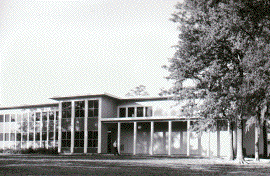 In 1962 the Department of Geology traded its home in Science (by now known as
the Old Science Building) for a temporary home in the two-story Geology Building.
This building was abandoned at the end of the fall semester of 1968 when the Science
Research (SR) Building was completed. In 1977 the "temporary" Geology Building was
loaded onto a large flatbed and moved across Cullen Boulevard to a "temporary" site
behind Robertson Stadium. Today it remains the "temporary" home of the UH Police Department.
In 1962 the Department of Geology traded its home in Science (by now known as
the Old Science Building) for a temporary home in the two-story Geology Building.
This building was abandoned at the end of the fall semester of 1968 when the Science
Research (SR) Building was completed. In 1977 the "temporary" Geology Building was
loaded onto a large flatbed and moved across Cullen Boulevard to a "temporary" site
behind Robertson Stadium. Today it remains the "temporary" home of the UH Police Department.
For a number of years the Board of Regents held discussions about the fate of UH. They believed that the school could only survive, evolve, and reach its full potential if state support was secured. The political machinations involved in this lengthy process are detailed in the book "In Time" by Patrick Nicholson. Suffice it to note that the Texas Legislature passed a bill creating UH as the newest State University in 1961. This bill became effective with the fall semester of 1963. The savings to students were enormous. In 1962 tuition and fees amounted to more than $ 750 per semester as compared with $ 125 per semester in 1963.
The summer field course remains a high (or low) spot for many of our alumni. We have collected some representative photographs from the Silver City period for your memory refreshment.
We know that Paul Fan led at least two expeditions into the Marathon Mountains of west Texas during the late 1940s. In the late 1950s Dr. Robert Greenwood started taking students to Silver City, New Mexico. With the exception of Dr. Walter Sadlick's excursion to northern Utah in 1964, the Silver City has remained our semi-permanent home base with minor modifications. In the 1980s, students split time between Silver City and Durango, Colorado. The field course was not offered for several years during the late 1960s because of low student enrollments. Dr. Carl Norman revived the Silver City experience in 1969 and for about 20 years faculty and students from UH spent a totally relaxing four to six weeks basking in the sunshine in southwestern New Mexico with side trips to the Grand Canyon, Durango, Colorado, Tony's Horseman, Maria's (under the smokestacks near the copper pit) and numerous sundry places known only to those that frequented them. Although many of the faculty helped to staff the Silver City experience, it was the efforts of Professors DeWitt Van Siclen, Carl Norman and Max Carman that kept the enterprise functioning. Since 1990, low student enrollments have made the summer field experience an every other year happening.

UH Geology Faculty - 1967-68
The End of the Mesozoic Grows Near and the Faculty Are Worried
>From Left to Right : Walter Sadlick, Margaret Bishop, Jim Solliday, Rosalie Maddocks, Carl Norman, Paul Fan, DeWitt C. Van Siclen, Max F. Carman, and Harvey Blatt
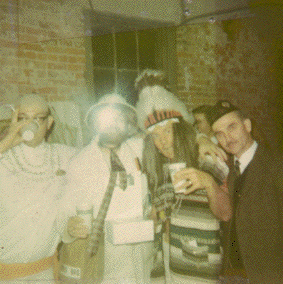
A less somber event was held to celebrate the end of the Mesozoic Era
From Left to Right : John Butler, Jim Solliday, Carl Norman and Max Carman
The Cenozoic
 The hiring of Elbert A. King(1969) from the Johnson Space Center, Houston, Texas, is taken as the start of the
Cenezoic Era. In January, 1969, the Department occupied quarters in the newly constructed
Science Research Building and we were about to begin a roller coaster ride of enrollment.
The hiring of Elbert A. King(1969) from the Johnson Space Center, Houston, Texas, is taken as the start of the
Cenezoic Era. In January, 1969, the Department occupied quarters in the newly constructed
Science Research Building and we were about to begin a roller coaster ride of enrollment.
Field experiences have been an integral part of our programs since the beginning. Many parents, spouses, and friends have wondered why their loved ones had to spend Thanksgiving or spring break away from home.
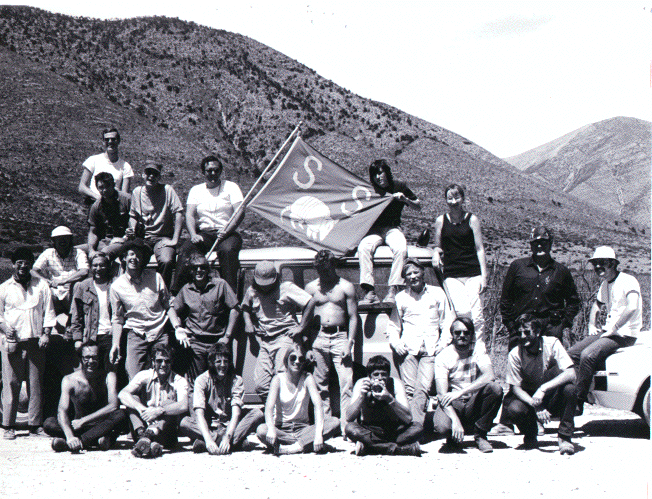
The Armidallo Army invades Saltillo, Mexico, March, 1972
Top row: Joe Millo, Ed McQuade, James Chude, Tim Kiefer, Mike Urbach, Irene Cookie
Jones
Middle row: David Richards, Jessie Vaughn, Dan Stewart, James Dale, Jane Bruton,
BIllie Long, Cecil Truss, Paul Tybor, Travis Allen, Mike Burnaman
Front row: Dale Carlson, Eric Sigmont, Ricahrd Hodgkinson, Pat Bryant, Bruce Birge,
Dale Order, Ralph Lloyd
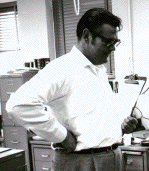 By the late 1960s the undergraduate curriculum had been modified (again) so that
all students were taking the same basic courses. The co-operative Geophysics program
with Physics became extinct in 1966 and its demise was immediately followed by the
planning of a Geophysics Option within the Department of Geology. Dr. Milton B. Dobrin, author and practicing geophysicist, was hired as a full-time faculty member in 1969
and a Geophysics Option was introduced almost immediately. In fact, however, Ralph
Johnson, (on the left) the first geophysics graduate student of the modern era, arrived
a year early in anticipation of this event. The program began with the Masters and
was part of the Doctoral program which was approved in 1975. An undergraduate option
was introduced in 1976.
By the late 1960s the undergraduate curriculum had been modified (again) so that
all students were taking the same basic courses. The co-operative Geophysics program
with Physics became extinct in 1966 and its demise was immediately followed by the
planning of a Geophysics Option within the Department of Geology. Dr. Milton B. Dobrin, author and practicing geophysicist, was hired as a full-time faculty member in 1969
and a Geophysics Option was introduced almost immediately. In fact, however, Ralph
Johnson, (on the left) the first geophysics graduate student of the modern era, arrived
a year early in anticipation of this event. The program began with the Masters and
was part of the Doctoral program which was approved in 1975. An undergraduate option
was introduced in 1976.
Geology + Geophysics = Geosciences

The Coordinating Board of Higher Education approved our application for a doctoral
program in 1974 and the first Ph.D. candidates were accepted into the program in the
fall semester of 1976. Earlier proposals for a Ph.D. program had been denied on the
basis that the new program would compete with existing programs and that the job market
would not support a new source of doctoral students. Bert King was instrumental in
changing these misconceptions.
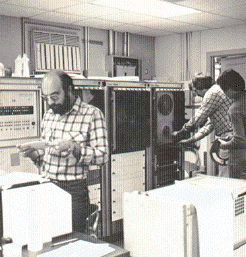 The Seismic Acoustics Laboratory (SAL) was founded by Professors Fred J. Hilterman (Geology) and Keith Wang (Electrical Engineering) in 1977. This industry sponsored
consortium evolved into the Allied Geophysical Laboratories (AGL) in 1981. The AGL
included the Research Computation Laboratory (RCL), the Field Research Laboratory
(FRL), the Image Processing Laboratory (IPL), the Well Log Laboratory in addition
to the SAL. The AGL is the "oldest" consortium at the University of Houston and has
supported more than 100 graduate students during its existence. On the left is an
image showing Edip Baysal, Fred Hilterman and Seung Chung at work in the SAL.
The Seismic Acoustics Laboratory (SAL) was founded by Professors Fred J. Hilterman (Geology) and Keith Wang (Electrical Engineering) in 1977. This industry sponsored
consortium evolved into the Allied Geophysical Laboratories (AGL) in 1981. The AGL
included the Research Computation Laboratory (RCL), the Field Research Laboratory
(FRL), the Image Processing Laboratory (IPL), the Well Log Laboratory in addition
to the SAL. The AGL is the "oldest" consortium at the University of Houston and has
supported more than 100 graduate students during its existence. On the left is an
image showing Edip Baysal, Fred Hilterman and Seung Chung at work in the SAL.
In 1981 the department's name was changed from Geology to Geosciences to better reflect the breadth of our faculty, students, and programs.
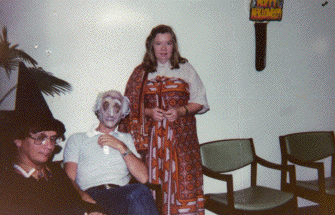
Yet another Faculty (Druid?) party was held to celebrate the approach of the Pleistocene.
From left to right : Bill Dupre, Stuart Hall and Rosalie Maddocks
The Pleistocene
Arch Reid was hired in 1987 as the Chair of the Department of Geosciences. Lots of things have happened in recent times and many are recorded in the main portion of our Internet site.
The continued decline in enrollment of majors continues to be a serious issue.
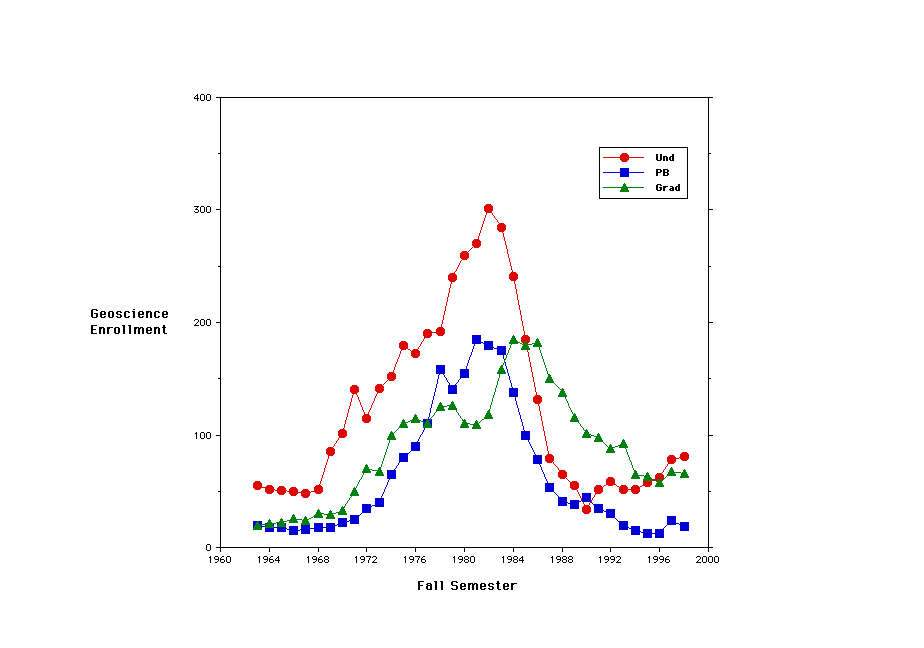
Variations in enrollment of undergraduate, PB, and graduate students in the Department
of Geosciences from 1963 (when we first became a state support university) to the
1998.
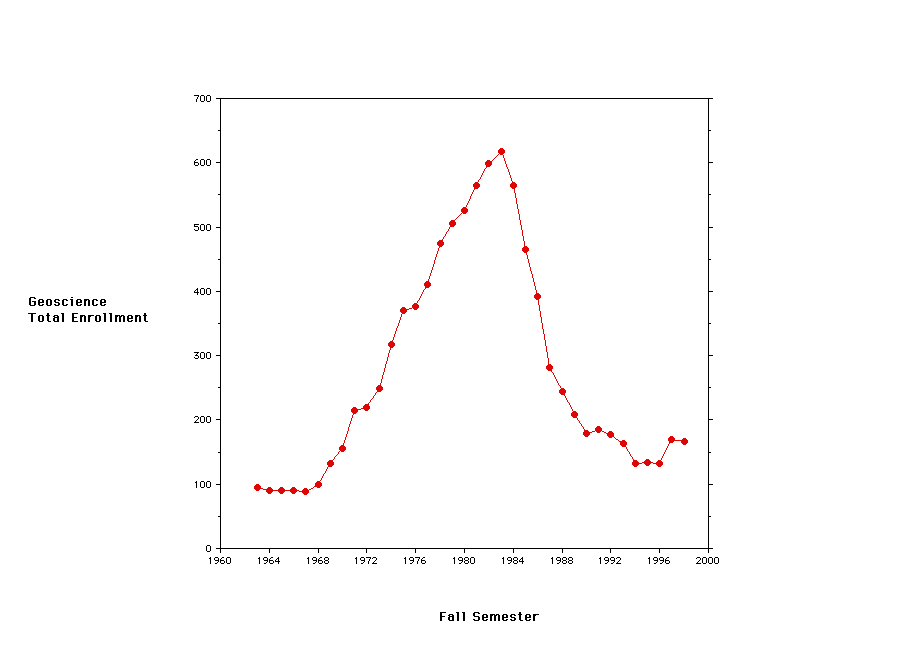
Variation in total enrollment of majors in the Department of Geosciences from 1963
(when we first became a state support university) to the 1998.
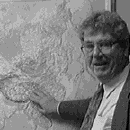 An electronic slide show of the faculty as they currently appear is given on the
right. While we don't have photographs of all of our faculty and students, we have
assembled a Rogues Gallery which we encourage you to pursue.
An electronic slide show of the faculty as they currently appear is given on the
right. While we don't have photographs of all of our faculty and students, we have
assembled a Rogues Gallery which we encourage you to pursue.
Comments and additions will be welcomed!
Full-Time Faculty of Geology/Geosciences
| Name | Time At UH | Specialty |
|---|---|---|
| Precambrian | No Full-Time Faculty | |
| Paleozoic | ||
| Keith M. Hussey | 1940-46 | Micropaleontology |
| George B. Somers | 1946-51 | Structural Geology |
| Asa A. L. Mathews | 1946-49 | Mineralogy |
| Paul Fan | 1947-78 | Geomorphology |
| Ellen L. Shook | 1948-51 | Laboratory Instructor |
| Mary Wood | 1948-53 | Paleontology |
| Louise B. Herrington | 1949-52 | Micropaleontology |
| Stewart H. Ross | 1949-54 | Structural Geology |
| Doris Malkin Curtis | 1950-53 | Sedimentology |
| James Bush | 1952-53 | Oceanography |
| Margaret Bishop | 1953-71 | Petroleum Geology |
| Pat K. Sutherland | 1953-56 | Paleontology |
| Max F. Carman | 1953-90 | Igneous Petrology |
| Robert Greenwood | 1954-56 | Mineralogy |
| Mesozoic | ||
| Henryk B. Stenzel | 1954-57 | Paleontology |
| Robert Perkins | 1955-57 | Paleontology |
| Porter M. Kier | 1955-57 | Paleontology |
| Jules R. Dubar | 1957-61 | Paleontology |
| Carl B. Rexroad | 1958-61 | Paleontology |
| DeWitt C. Van Siclen | 1960-83 | Petroleum Geology |
| Lee Harvil | 1960-62 | Stratigraphy |
| Hunter C. Goheen | 1961-63 | General Geology |
| Harvey Blatt | 1962-67 | Sedimentology |
| Walter Sadlick | 1963-69 | Paleontology |
| Nicholas Short | 1964-67 | Mineralogy/Geochemistry |
| James R. Solliday | 1964-74 | Field Geology |
| Carl Norman | 1965-present | Structural Geology |
| E. Alan Lohse | 1966-71 | Oceanography |
| Rosalie Maddocks | 1967-present | Micropaleontology |
| Edward J. Sawberger | 1968-73 | Laboratory Instructor |
| John C. Butler | 1968-present | Mineralogy |
| Cenozoic | ||
| Elbert A. King | 1969-98 | Space Geology/Meteoritics |
| Milton B. Dobrin | 1969-79 | Geophysics |
| Henry S. Chafetz | 1970-present | Sedimentary Petrology |
| Ian Evans | 1971-present | Stratigraphy |
| Hallan Noltimer | 1971-74 | Geophysics |
| Jerry Kier | 1972-75 | Marine Geology |
| Fred J. Hilterman | 1974-80 | Geophysics |
| William R. Dupre | 1976-present | Sedimentology |
| Roger S. U. Smith | 1976-81 | Geomorprhology |
| Stuart A. Hall | 1977-present | Geophysics |
| Jack F. Casey | 1980-present | Structural Geology |
| Don Elthon | 1981-89 | Geochemistry |
| John McDonald | 1981-95 | Geophysics |
| Robert Sheriff | 1981-present | Geophysics' |
| Alex Woronow | 1982-97 | Computer Applications |
| Kevin Burke | 1983-present | Plate Tectonics |
| James Lawrence | 1984-present | Isotope Geochemistry |
| Pleistocene | ||
| Arch Reid | 1987-present | Geochemistry/Meteoritics |
| Regina Capuano | 1989-present | Hyrdology |
| Hua-Wei Zhou | 1989-present | Geophysics |
| Copeland, Peter | 1990-present | Isotope Geochemistry |
Chairmen of Geology/Geosciences
| Name | Time At UH |
|---|---|
| Keith M. Hussey | 1940-46 |
| George M. Somers | 1947-51 |
| Stewart A. Ross | 1951-52 |
| Paul Fan | 1952-53 |
| Henryk Stenzel | 1954-56 |
| Paul Fan | 1956-60 |
| DeWitt C. Van Siclen | 1960-67 |
| Margaret Bishop | 1967-69 |
| Elbert A. King | 1969-74 |
| John C. Butler | 1975-85 |
| Max F. Carman | 1985-87 |
| Arch Reid | 1987-93 |
| Stuart A. Hall | 1993-1999 |
| Jack Casey | 1999-2012 |
| Christopher Liner | 2012 |
| Janok Bhattacharya | 2012-2013 |
| Hua-Wei Zhou | 2013 |